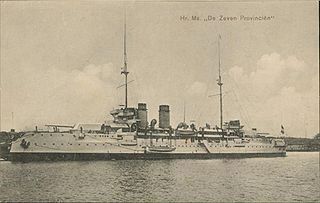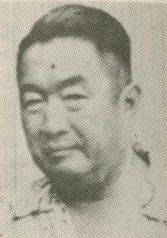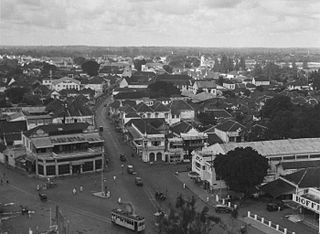
Karel Willem Frederik Marie Doorman was a Dutch naval officer who during World War II commanded remnants of the short-lived American-British-Dutch-Australian Command naval strike forces in the Battle of the Java Sea. He was killed in action when his flagship HNLMS De Ruyter was torpedoed during the battle, having chosen to go down with the ship.

HNLMS De Zeven Provinciën was a Royal Netherlands Navy coastal defence ship in service from 1910 until 1942. It was a small cruiser-sized warship that sacrificed speed and range for armor and armament. She was armed with two 283 mm, four 150 mm, ten 75 mm, four 37 mm guns, in addition to a few 75 mm mortars. She was 101.5 metres (333 ft) long, had a beam of 17.1 metres (56 ft) and a draft of 6.15 metres (20.2 ft), and displaced 6,530 tons. She had a crew of 448 and was able to reach 16 knots.
The Netherlands Naval Aviation Service is the naval aviation branch of the Royal Netherlands Navy.

Louise Johanna "Anneke" Grönloh was an Indonesian-born Dutch singer. She had a successful career starting in 1959 that lasted throughout the 1960s, and scored a hit with "Brandend zand", one of the best-selling Dutch songs of all time.

Fred Young was an ethnic Chinese film director and producer active in the Dutch East Indies and its successor state, Indonesia. He reportedly studied film in Hollywood as a youth, but only entered the nation's film industry in 1940. After he made his debut as a writer with Sorga Palsoe, he was involved in some 36 productions, 23 as director.

Ujung Water Palace is a former palace in Karangasem Regency, Bali. Now, this palace also known as Ujung Park or Sukasada Park. It is located approximately 5 kilometres from Amlapura. In the Dutch East Indies era, this place known by the name Waterpaleis. The palace has three large pools. In the middle of the pool, there is the main building named Gili Bale, connected to the edge of the pool by bridge.

The French and British interregnum in the Dutch East Indies of the Dutch East Indies took place between 1806 and 1816. The French ruled between 1806 and 1811, while the British took over for 1811 to 1816 and transferred its control back to the Dutch in 1816.

Colonial architecture in Surabaya includes the legacy of neoclassical architecture and Dutch architecture built during the Dutch East Indies era. The old city in Surabaya is a tourist attraction but faces problems with the deterioration of older buildings. It includes Dutch architecture, has an Arab quarter and areas exhibiting Chinese influence. Jembatan Merah is an area known for its Dutch architecture.

Indies Empire style is an architectural style that flourished in the colonial Dutch East Indies between the middle of the 18th century and the end of the 19th century. The style is an imitation of neoclassical Empire Style which was popular in mid-19th-century France. Conformed to the tropical setting of Indonesia, the style became known in the Dutch East Indies as Indies Empire style.

HNLMS Koningin Emma der Nederlanden was an Atjeh-class unprotected cruiser of the Royal Dutch Navy.

Pieter Koenraad was a Dutch Naval Officer, the Rear-Admiral of naval forces in the Dutch East Indies between 1943 and 1946, during World War II. Before the Japanese invasion of the Dutch East Indies, he was the flag officer in command of the important naval base at Soerabaja.

Volharding Dock, was a floating dry dock built for the Nederlands Indische Droogdok Maatschappij (NIDM) in the 1870s. It was the smallest of two unique tower dry docks, and the only one that would actually be put in use.
Nankai was a Dutch ship that was seized by Imperial Japanese Navy during World War II and converted into a gunboat.
The Mariniersbrigade was a marine unit set up by the Dutch government-in-exile during World War II, which existed between 1943 and 1949. It was formed as part of the Dutch contribution to the Allied war effort against Japan and more particularly for the liberation of the Dutch East Indies. The driving force behind its creation was marine colonel M. R. de Bruyne. The Mariniersbrigade became an independently operating unit with a strength of approximately 5,000 men. Capable of amphibious landings, the unit had a core of three infantry battalions, and was further equipped with landing craft, artillery and tanks.

Naval Base Borneo and Naval Base Dutch East Indies was a number of United States Navy Advance Bases and bases of the Australian Armed Forces in Borneo and Dutch East Indies during World War II. At the start of the war, the island was divided in two: British Borneo and Dutch East Indies. Both fell to the Empire of Japan, Japan occupied British Borneo and the Dutch East Indies in 1942 until 1945.
The P 1-class was a ship class of four patrol vessels that were built at the Marine Etablissement te Soerabaja in the Dutch East Indies. They were the first patrol vessels that were built in the Dutch East Indies for the Royal Netherlands Navy.

HNLMS Krakatau was a minelayer of the Royal Netherlands Navy (RNN). She was built in the Dutch East Indies and served between 1924 and 1942 in the RNN.

HNLMS Pro Patria was a minelayer of the Royal Netherlands Navy (RNN). She was built in the Dutch East Indies and served between 1923 and 1942 in the RNN.

HNLMS Rigel was a multi-purpose steamship of the Government Navy that could also be used as minelayer and as yacht for the Governor-general of the Dutch East Indies. The ship was militarized in 1939 and taken into service of the Royal Netherlands Navy, where it served as minelayer between 1939 and 1942.
HNLMS Pollux was a steamship of the Dienst der Bebakening en kustverlichting. She was built in the Netherlands and used as lightship and beacon ship. In 1939 the ship was militarized and taken into service of the Royal Netherlands Navy.


















